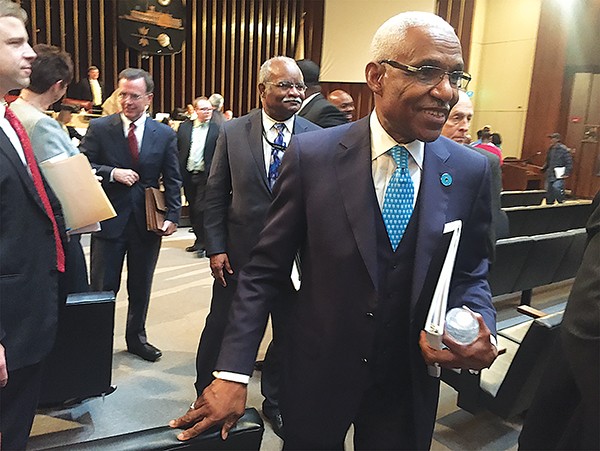 Toby Sells
Toby Sells
Mayor A C Wharton
This is an open letter to Memphis Mayor A C Wharton. Yes, you’re still the mayor. You will be until December 31st, 2015. That gives you roughly 10 weeks left in office as the leader of Memphis. I’m just wondering what you plan to do in the next 10 weeks.
First, let me say that I have no beef whatsoever with Mayor-elect Jim Strickland. I haven’t met Mr. Strickland yet, and I hope he is wildly successful in making the hometown I love so much a better place. More than anything right now, though, I want to thank you, Mayor Wharton, for doing just that.
I think you have done a fantastic job in your roles as public defender, county mayor, and mayor of the city, despite the odds you have faced. In addition to your passionate work to get guns off the streets, help incarcerated, mentally disabled people get a fair shake, make Memphis a healthier city, and help distressed neighborhoods become thriving centers of commerce, culture, and hope, you have done this with grace, intelligence, and the sharpest sense of both honest concern and a sense of humor. You are one of the funniest people I’ve ever known, and I love that about you. A wit as quick as yours in a politician? Pretty rare.
But I also love your serious side and the fact that you seem to be able to always be at 10 places at once every day of every week. When something bad happens, you are there to try to come up with the answers. When something good happens, you are there to share the moment and pat people on the back for a job well done. You’re an incredible ambassador for Memphis, everywhere you go. Are you perfect? Nah. Nobody is. I don’t know a lot about politics, but I know something about good people, and you are certainly that. I’m proud to call you a friend.
The day after the October 8th election, I read a very disconcerting headline that proclaimed, “In humiliating loss, Wharton has only self to blame.” You’re probably too much of a gentleman to respond to that opinionated, kick-’em-when-they’re-down kind of smear tactic, but I will go on record saying that you have nothing to be humiliated about. It’s politics. Times change. The world keeps spinning. And the 15 million or so people who come here from all over the world every year to experience Memphis will continue to come to one of the coolest cities in the world, a city in which the majority of its residents don’t have a clue what a pilgrimage that is for so many of them.
Because so many people blame you for every single thing that goes wrong in Memphis, I’m going to give you credit here for every good thing that has happened during your mayoral tenure. Your Mayor’s Innovation Team, under your direction, has done wonders for areas like Broad Avenue and Crosstown. Those once-dilapidated, sad places are now so thriving that other cities should be following the revitalization model your team has set forth. While a lot of other people also deserve credit for that, you should certainly take credit, too. The transformations began under your watch. Likewise with Overton Square, one of the best urban success stories in the country right now. Same with the South Main Arts District, Chisca Hotel, Front Street, Soulsville, Beale Street, Cooper Street, and now, finally, hopefully, Clayborn Temple across from the FedExForum. Take credit, Mr. Mayor. A lot of great things have happened in Memphis with you at the helm.
Perhaps the most existentially important things that have happened on your watch are the renaming of the city parks formerly known as Confederate Park, Nathan Bedford Forrest Park, and Jefferson Davis Park, things that baffled those 15 million visitors a year to Memphis — and many of us who live here. That was an awesome accomplishment and proof of progress directed at no longer honoring and paying tribute to slave owners. Yep, it’s that simple.
Which brings me back to my initial question of what you plan to do in these last 10 weeks in office. In the aforementioned newspaper article that declared your mayoral election results a “humiliating loss,” the writer also mentioned that “Everyone’s seen the cranes in Nashville, seen the resurgence so many other cities are enjoying, and wondering why they weren’t seeing enough of it here.”
First off, the reason there are so many cranes in Nashville is that over there they are demolishing historic landmarks as fast as they can to build hideous, generic-looking condominiums. The resurgence of Memphis has been more carefully executed. It’s a bit subtler than Nashville, but then Nashville is more about glitz and glamour.
I would like to see one big crane, though. I remember my heart sort of leaping out of my chest not too long ago, when I read or heard that you, the mayor, personally issued a request that the city remove the statue of Nathan Bedford Forrest that still resides in the park on Union Avenue that used to bear his name. I don’t know what the status of that request is now. The crane I’d like to see before you leave office is the one extracting the statue of Nathan Bedford Forrest from that park and moving it wherever it is most out of view. The park has been renamed, so why not move it? I would give anything if you could pull that off by the time your term is up. I’d be happy to help.
 Jackson Baker
Jackson Baker